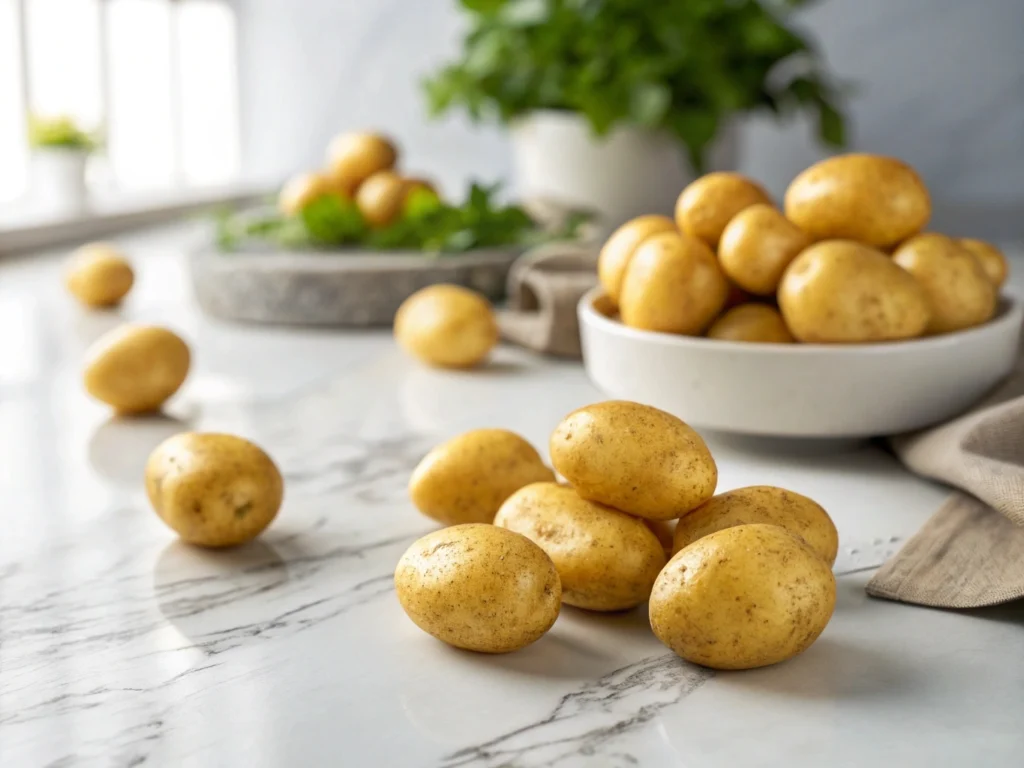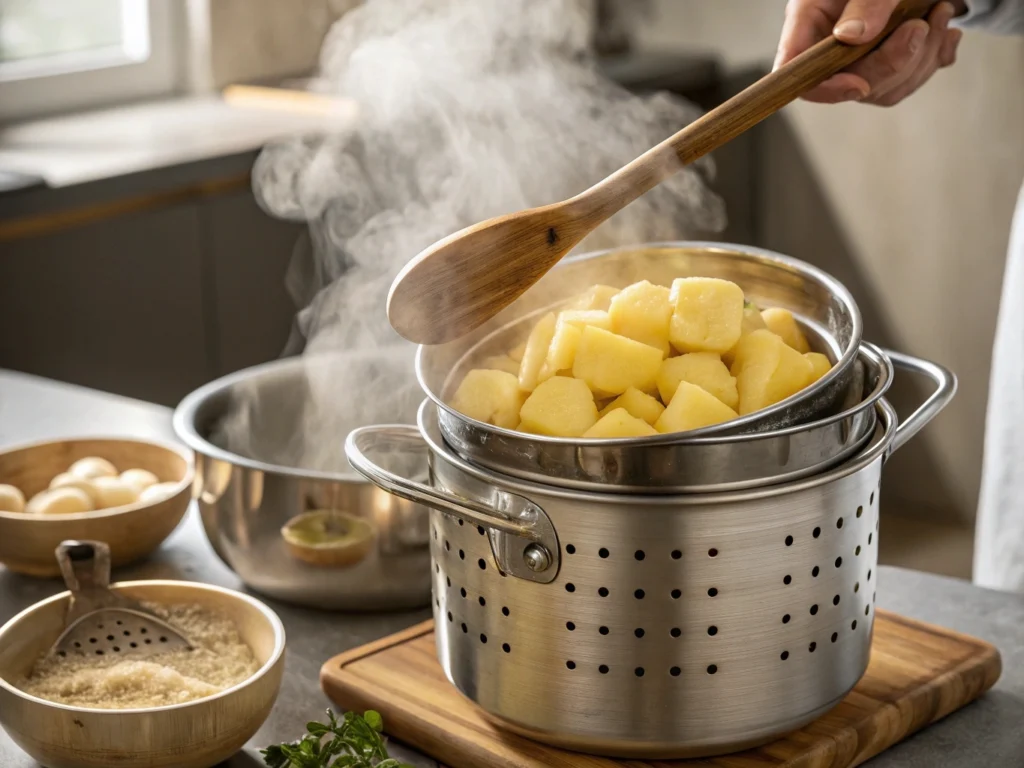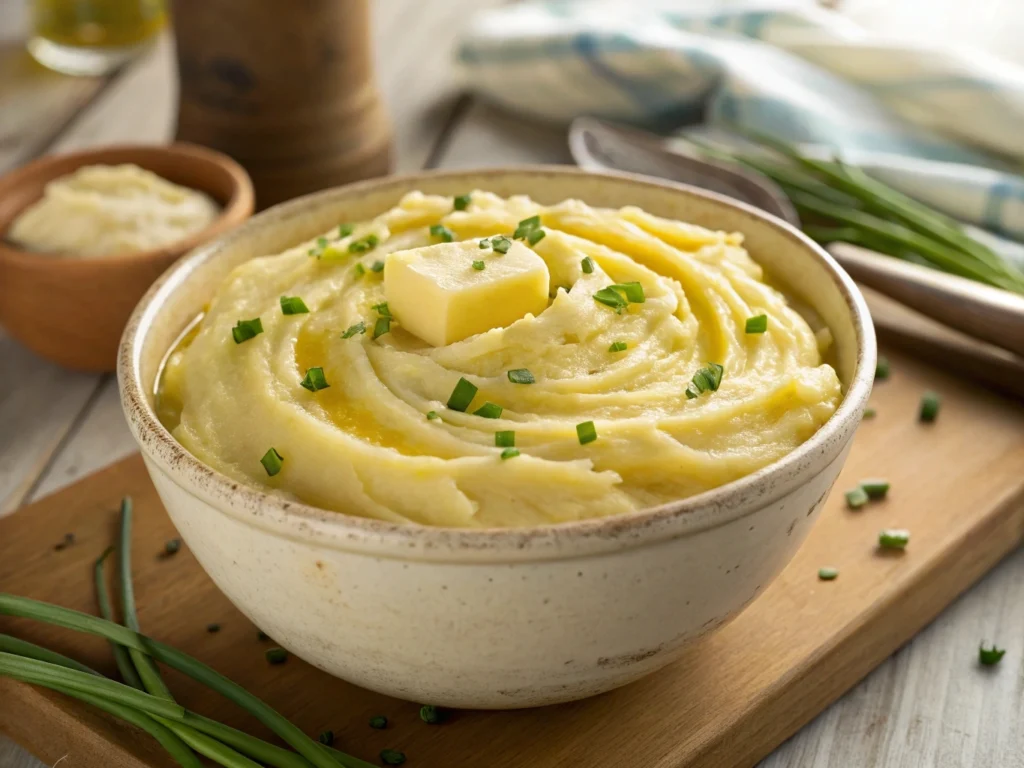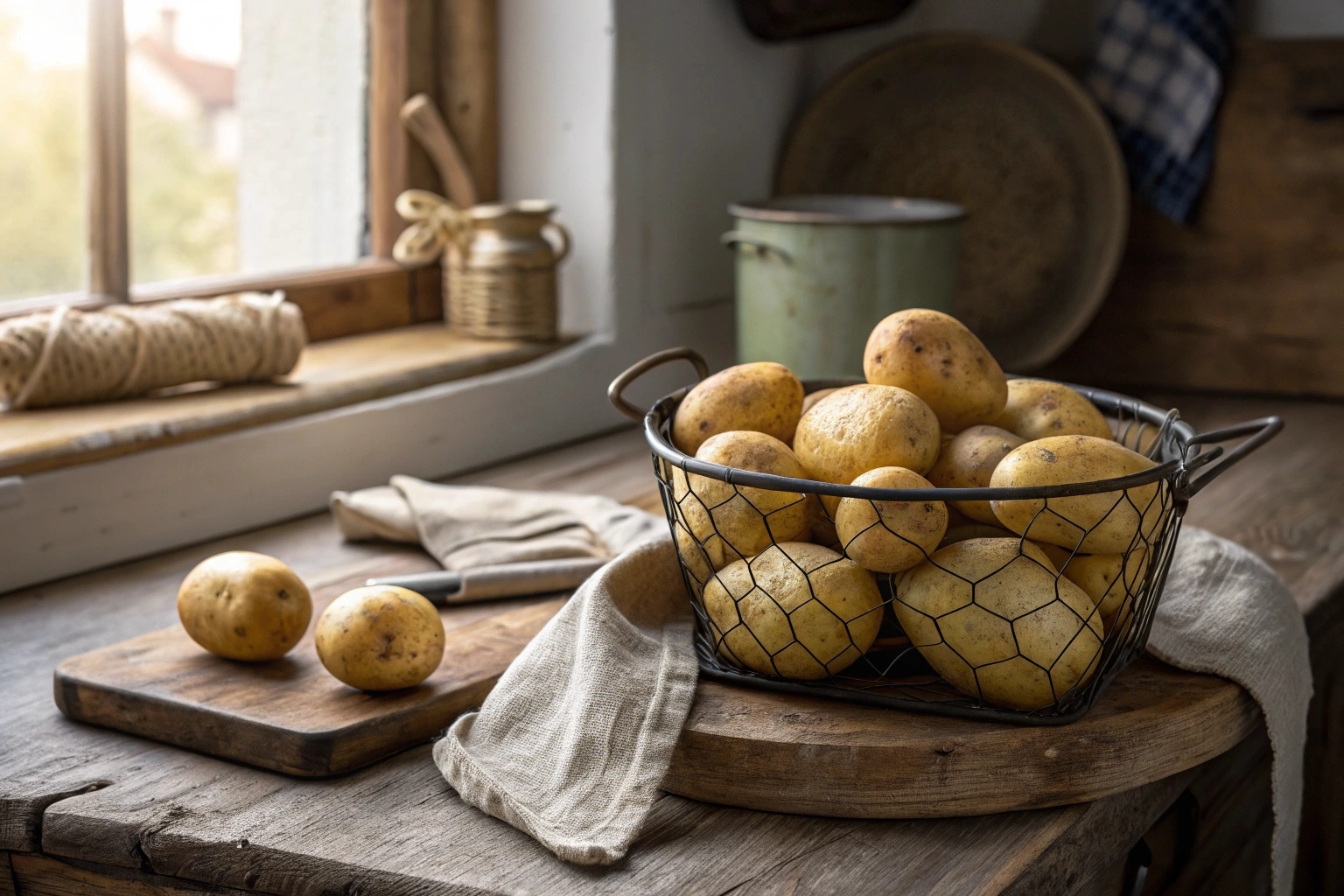Have you ever wondered why some mashed potatoes taste so creamy and flavorful without needing loads of extra butter? Yukon Gold potatoes may be the secret. In this guide, you will learn about their history, best cooking methods, and why they are prized by cooks everywhere. Moreover, you will discover an easy recipe for silky mashed potatoes that will impress your family and friends. Let’s dive in!
Why Yukon Gold potatoes Deserve the Spotlight
Have you ever bitten into a potato dish that practically melted in your mouth, leaving a slightly sweet and buttery impression behind? If so, there is a good chance it featured the famed Yukon Gold variety. While it is easy to think of potatoes as a simple staple, these spuds have many nuances. Thus, understanding why they shine can help you elevate your cooking game, no matter your level of expertise.
Yukon Gold potatoes, in particular, have a reputation for being one of the most flavorful, visually appealing, and adaptable varieties available. On the one hand, many conventional potatoes require heavy seasoning to bring out their best side. On the other hand, Yukon Golds already have a nuanced taste that requires minimal enhancement. However, you can still jazz them up with herbs, cheeses, or sauces for an elevated meal.
What Are Yukon Gold Potatoes?
History and Origins of Yukon Gold potatoes
The story of this golden-fleshed variety begins in Ontario, Canada. In the 1960s, agricultural scientists set out to develop a new type of potato that combined the best traits of both wild South American yellow potatoes and North American white potatoes. Their goal was to create a high-yielding, disease-resistant cultivar with a distinctive color and taste. After years of careful cross-breeding and testing, Yukon Gold potatoes were finally introduced to the market.
They are now widely grown in multiple regions, including Idaho in the United States. In fact, because they quickly gained popularity, you will frequently find them at local supermarkets, farmers’ markets, and even in the gardens of avid home growers who appreciate how relatively straightforward these potatoes can be to cultivate. Meanwhile, the shorter harvest window from around August to February makes them slightly more seasonal compared to other varieties that may be available year-round. However, this timing adds to their allure, encouraging many people to look forward to the period when Yukon Golds are at peak freshness.
Defining Characteristics

Appearance
One of the first things you will notice about Yukon Gold potatoes is their thin, smooth skin. While some potatoes have robust, thick exteriors, these golden beauties have a more delicate surface. Their skin often has subtle rosy pink eyes, giving them a distinctive look that stands out from the moment you spot them in the produce aisle. Beneath that thin skin lies vibrant yellow flesh, which is a strong visual indicator of their naturally buttery taste.
Texture
Yukon Golds are frequently described as possessing a texture that sits halfway between the dryness of a starchy Russet and the firm, waxy nature of red potatoes. In other words, they strike the perfect balance. Thus, you can count on them to hold their shape in stews or braises without falling apart, while still offering a creamy consistency when mashed. This versatility is one of their primary selling points.
Natural Flavor
Another distinctive trait is the noticeable buttery sweetness that comes through, even before you add any seasoning. Therefore, a simple preparation—like roasting or boiling—often yields a delicious outcome without the need for heavy sauce or added fats. Nevertheless, people who enjoy customizing flavors with extra herbs, garlic, or cheeses will find that Yukon Golds serve as a delightful canvas for various culinary experiments.
Seasonal Availability and Cost
You can usually find these potatoes from late summer through winter. However, keep in mind that availability can vary by region, and some grocers maintain stocks all year. Because they are in high demand and have a slightly shorter harvest season, Yukon Golds often cost a bit more than typical white or red potatoes. Yet, they usually remain less expensive than specialty varieties like fingerlings or certain heirloom types. If you are on a tight budget, watch for seasonal sales or consider growing your own if you have access to a garden plot.
Why Choose These Yukon Gold potatoes?
Balance of Starch and Moisture
Yukon Gold potatoes offer a medium starch content, which is crucial for achieving a texture that is not too mealy yet not overly firm. In contrast, Russets contain higher starch levels, which gives them that fluffy quality many people enjoy in baked potatoes. On the other hand, red potatoes have a waxier, firmer feel. Meanwhile, Yukon Golds land comfortably in the middle, ensuring they can be used in an incredible array of recipes.
Because they have more moisture than Russets, Yukon Golds do not dry out as easily when baked or roasted. Therefore, you can slice or dice them for soups and stews, confident that they will maintain their structure. They also make exceptionally creamy mashed potatoes, which we will discuss in more detail later.
Naturally Buttery Taste
One of the prime reasons people gravitate to Yukon Golds is their buttery flavor, which is slightly sweet. This subtle sweetness interacts beautifully with savory ingredients like garlic, onions, and herbs. Thus, it is no wonder professional chefs often showcase them in dishes where the potato is meant to shine, such as pommes purée (a silky, French-style mashed potato) or a rustic potato soup where flavor depth is essential.
In addition, the golden color plays a psychological role by reinforcing that impression of creaminess and richness, even before you take a bite. On the other hand, white potatoes may lack that visual cue and can appear more neutral in presentation.
Versatility in the Kitchen
A big advantage of these tubers is their ability to adapt to different cooking methods:
- Roasting: Thanks to their light skin, you can roast them with olive oil, salt, pepper, and maybe some rosemary to create a side dish that is crispy on the outside yet soft on the inside.
- Mashing: Their moderate starch content ensures a creamy consistency without turning gummy, which is a risk if you use ultra-starchy varieties and over-mix them.
- Stews and Soups: Because they hold up without disintegrating, Yukon Golds are excellent for simmering over longer periods in broths or sauces.
- Steaming: This method helps them stay moist and flavorful while retaining more nutrients than boiling might.
However, they are not ideal for making French fries. Since these golden spuds carry more water than some varieties, achieving that crisp exterior can be trickier without specific techniques. Nevertheless, they excel in almost every other cooking method you can think of.
Where to Buy and How to Store Yukon Gold potatoes
Where to Purchase
Yukon Golds are fairly common, so you will likely find them in large grocery stores, specialty supermarkets, health food stores, and even online retailers. Look for labels or signage that specifically read “Yukon Gold” or identify them by their distinctive yellow flesh. Furthermore, you can sometimes purchase them in bulk bins if you only need a few. Alternatively, they are sold in 5- or 10-pound bags that are perfect if you plan to cook multiple potato-centric meals in a week.
In addition, farmers’ markets often have fresh, locally grown Yukon Golds when they are in season, which can provide an even more flavorful product. If you are the gardening type, you might consider buying seed potatoes and planting them in your backyard. Growing your own can be rewarding, but it does require proper soil, space, and diligence in pest management.
Selecting Quality Potatoes
When choosing your potatoes, inspect them carefully for any signs of damage. Therefore, avoid those with bruises, cuts, or soft spots. Additionally, watch out for any greenish hue, which indicates the presence of solanine—a substance that can impart bitterness and cause discomfort if consumed in large quantities. A few small green patches can be trimmed away, but if half the potato is green, you are better off discarding it.
Storing Your Yukon Gold potatoes
Proper storage helps ensure your potatoes remain fresh and flavorful. Since Yukon Golds have a slightly higher sugar content than some other varieties, they can start to turn sweet or grow sprout eyes if kept in poor conditions.
- Cool, Dark Place: Aim for a temperature range of 40 to 50°F. Storing them in a paper or perforated plastic bag allows for airflow and prevents moisture buildup.
- Avoid Light: Exposure to sunlight triggers the production of solanine, turning potatoes green and causing a bitter taste. Keep them in a cupboard, pantry, or refrigerator crisper.
- Keep Away from Onions: Onions and potatoes release gases that can accelerate spoilage when they are placed together.
- Use Within Several Weeks: Yukon Golds do not last quite as long as Russets, so plan your meals accordingly.
Cooking Methods and Best Practices
Preparation Tips
Before you start cooking, give the potatoes a light scrub to remove any lingering dirt. However, do not wash them far in advance, as moisture can lead to premature sprouting or rot during storage. The thin skin means you can opt to peel them for a more refined texture or leave the peels on for extra fiber and nutrients. In addition, consider cutting them into uniform pieces. This consistency ensures even cooking whether you are steaming, boiling, or roasting.
Ideal Cooking Approaches

- Steaming: Steaming is a gentle way to cook the potatoes without submerging them in water. Therefore, they retain more minerals and vitamins, not to mention a more intense flavor.
- Boiling: If a steamer is not available, boiling Yukon Golds in salted water is an excellent fallback. Just be sure not to overboil them or they may become waterlogged, diluting that subtle sweetness.
- Baking: Consider baking your potatoes if you want a hands-off approach. Brush them with a little oil, prick with a fork, and pop them in the oven. The thin skin becomes slightly crispy, but not as thick as a typical Russet’s.
- Roasting: Toss cubes or wedges of these spuds with olive oil, herbs, salt, and pepper, then roast at around 400 to 425°F. Their natural sugars caramelize at the edges, resulting in a deliciously crisp outer layer and a creamy interior.
- In Soups and Stews: Yukon Golds shine in slow-cooked dishes because they do not break down rapidly. Whether you are preparing a hearty beef stew or a vegetarian chowder, they will hold their shape yet remain tender.
Texture and Flavor Insights
Thanks to their moderate starch content and higher moisture, Yukon Golds often require less added cream or butter compared to drier varieties. In addition, their sweet, vegetal notes form a beautiful partnership with aromatic herbs like rosemary, thyme, or chives. On the other hand, if you prefer a smoky flavor, consider adding bacon bits or smoked paprika, which can accentuate their natural richness.
Mashed Potatoes: A Buttery Recipe to Try

Now that we have explored why these spuds are so special, let us dive into a recipe that showcases them in one of the most comforting forms: mashed potatoes.
Ingredients
- 2 pounds of Yukon Gold potatoes, peeled or unpeeled, cut into 1-inch chunks
- 3 tablespoons of butter (salted or unsalted)
- 2 cloves garlic, minced (or 1 tablespoon of roasted garlic for a sweeter note)
- ½ cup heavy cream (you can also use half-and-half or whole milk)
- 1 teaspoon fine sea salt (plus additional to taste)
- Chopped chives (optional garnish)
Tip: If you want a tangy twist, keep some sour cream on hand. Meanwhile, roasted garlic can add a sweet, complex flavor that elevates the dish even further.
Step-by-Step Instructions
- Steam the Potatoes
Place the potato chunks in a steamer basket over boiling water. Cover and steam for about 15 to 20 minutes. Test a piece with a fork—it should slide in easily. If you prefer boiling, place the chunks in lightly salted water and cook for the same duration, being careful not to overdo it. - Heat Butter and Garlic
Meanwhile, melt the butter in a small saucepan over low heat. Therefore, add the minced garlic and stir gently for about 1 minute or until fragrant. Avoid browning the garlic, as it can turn bitter. - Add Cream
Stir in the heavy cream (or your chosen dairy) along with the salt. Let the mixture warm through, but do not allow it to boil. This step helps ensure that you are not shocking the potatoes with cold ingredients later. - Mash or Rice
Drain the potatoes (if you boiled them) or remove the steamer basket. Transfer the hot chunks to a large bowl. Consequently, use a ricer or food mill for the smoothest, most luxurious texture. If you prefer a more rustic style, grab a hand masher and go to town. However, do not use a blender or food processor, as that can make the potatoes gummy. - Combine and Garnish
Slowly pour in the warm butter-cream mixture, stirring gently until everything is well combined. Taste to check if you need more salt. Finally, top with fresh chives if you want a pop of color and mild onion-like flavor. Serve immediately, or keep them warm in a covered dish until mealtime.
Helpful Tips and Variations
- Avoid Overworking: It is crucial not to mix the potatoes too aggressively, which can release extra starch and yield a gluey texture.
- Roasted Garlic Variation: If you have a bit of extra time, wrap a head of garlic in foil with a drizzle of oil, roast at 400°F for about 30 to 40 minutes, and squeeze the softened cloves into your mashed potatoes. Consequently, it adds a sweet complexity that raw garlic cannot match.
- Make-Ahead Option: Mashed potatoes can be prepared up to two days in advance. Cool them, cover them tightly, and store them in the refrigerator. Reheat gently on the stove with a splash of milk to bring them back to creamy perfection.
- Serving Suggestions: Pair them with meatloaf, roasted chicken, or a vegetarian main dish like grilled mushrooms for an easy yet satisfying meal. If you want a festive flair for the holidays, add some sour cream or Parmesan cheese to the mix.
Comparing to Russet Potatoes
Many people wonder whether Yukon Golds can substitute for Russets or vice versa. Indeed, there is no single answer; it often depends on the dish you want to create.
- Moisture Content: Russets are drier, making them ideal for baked potatoes with that characteristic fluffy center. Yukon Golds contain more water, so they turn out creamier when mashed.
- Flavor Profile: While Russets have an earthier, more neutral taste, Yukon Golds possess a lightly sweet, buttery flavor. Therefore, you can often use fewer extra fats or seasonings when cooking with them.
- Best Uses: Russets make excellent fries and crispy roasted wedges if that is your preference. Yukon Golds can crisp up, but they truly excel in recipes that need a moist, tender potato—like soups, stews, or mashes.
- Gnocchi Consideration: Some cooks swear by Russets for making light, airy gnocchi because of their low moisture content. On the other hand, Yukon Golds can yield a slightly denser dumpling, which some people prefer for heartier sauces.
In short, choose Yukon Golds when you want an inherently flavorful, creamy texture in your dish, and opt for Russets if you are aiming for fluffy bakes or crispy fries. Nevertheless, there is ample room for experimentation, especially if you love exploring new textures and flavors in the kitchen.
Nutritional Information for Yukon Gold Potatoes
Similarities with Russets
Despite their differences in moisture and flavor, Yukon Golds and Russets have strikingly similar nutritional profiles. Both varieties are:
- Naturally Fat-Free, Sodium-Free, and Cholesterol-Free
- High in Carbohydrates, making them a solid source of energy
- Loaded with Potassium: A medium-sized potato typically offers more potassium than a banana.
- Rich in Vitamin C: This nutrient contributes to immune function and overall health.
Vitamins, Minerals, and Fiber
A medium 5.3-ounce potato with the skin on provides roughly 2 grams of fiber and about 3 grams of protein, in addition to the carbohydrates that form the bulk of its caloric content. Therefore, if you are seeking a balanced diet, these spuds can be a valuable component, particularly when combined with protein sources like beans, poultry, or fish. To explore more detailed nutritional data, you might check out the USDA Nutrient Database, which provides extensive information on the macro- and micronutrient compositions of many foods.
Healthy Cooking Tips
Although potatoes themselves are quite nutritious, the preparation method can significantly influence their health factor. Therefore, try these strategies:
- Go Easy on the Added Fats: Use smaller amounts of butter or oil, and focus on flavoring with herbs, spices, and low-sodium broths.
- Incorporate the Skin: Leaving the skin on adds extra fiber and some vitamins.
- Portion Control: While potatoes can be part of a balanced meal, keep portion sizes in check to avoid excessive caloric intake.
Make Ahead, Storage, and Reheating
Storing Leftover Cooked Potatoes
Leftover cooked potatoes last about three days in the fridge. However, it is a good idea to store them in an airtight container, as exposure to air can dry them out or cause off flavors. For maximum freshness, try to use them within that three-day window.
Reheating Methods of Yukon Gold potatoes
- Stovetop: If you have leftover mashed potatoes, add a spoonful or two of milk or water to a saucepan. Heat them over medium-low, stirring frequently to distribute the heat evenly.
- Oven: Another option is to place mashed or roasted potatoes in a covered baking dish and warm them in a 350°F oven until heated through, typically 20 to 30 minutes depending on the quantity.
- Microwave: For speed, the microwave can work for smaller portions. However, do so in short bursts, stirring each time to minimize hot spots and dryness.
Freezing Guidelines of Yukon Gold potatoes
Mashed Yukon Gold potatoes can be frozen for up to three months, but be aware that the texture may become slightly grainy once thawed. If you decide to freeze them, consider adding a bit more cream or butter to help maintain smoothness. On the other hand, if you freeze diced or cooked potato chunks, they may develop a mealy quality. Still, they can be acceptable for soups or stews after thawing since their consistency will be less noticeable in a broth.
Looking for another cheesy delight? Check out our Cheesy Chicken Sloppy Joe Recipes for an easy and satisfying meal option.
Conclusion
Yukon Gold potatoes Advantages
In summary, Yukon Gold potatoes excel in many dishes thanks to their moderate starch content, gorgeous yellow hue, and subtly sweet, buttery taste. Whether you want to create a simple side of roasted potatoes, a comforting pot of soup, or a luxurious bowl of mashed potatoes, this variety delivers both flavor and visual appeal. Additionally, their adaptability allows them to stand in for other potato types in many recipes, although each variety has its own specialty.
Share Your Experience
Have you tried making our mashed potato recipe, or are you planning on experimenting with these golden tubers for the first time? We would love to hear about your experiences, tips, or any creative twists you have discovered. Feel free to leave comments below or reach out on social media to share how Yukon Golds have transformed your dishes.
If you are interested in learning even more about potatoes, such as detailed recipe ideas or nutritional insights, visit the Idaho Potato Commission for additional trustworthy resources and inspiration. Moreover, do not forget to check your local farmers’ market or trusted grocery stores for the freshest batches of these golden spuds when they are in peak season.

